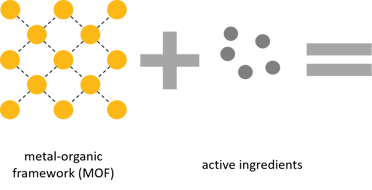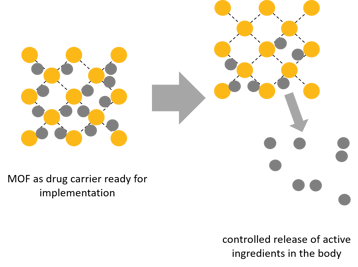Starting with the first publication about metal-organic frameworks (MOFs) in 1999, MOFs have seen a rapid growth in the last years and have proven to be of great interest to the pharmaceutical industry. MOFs can improve drug delivery, stabilize enzymes or improve osseointegration of implants. Discover the opportunities MOFs offer for pharmaceutical applications.
As the name suggests, metal-organic frameworks feature highly-structured frameworks of metal ions/clusters connected with organic linkers. Like a sponge, metal-organic frameworks can take-up, hold and release molecules from their pores. The application of MOFs are seemingly endless, as the building blocks – metal ions and organic linkers – can be chosen almost without limitations. From combinations of single metal and single organic linker to multiple metals and multiple linkers. Furthermore, the framework itself can be either rigid or flexible, depending on the base materials. This tunability makes the so versatile – from harvesting water from dry air to improved gas storage.
These characteristics make MOFs perfect for pharmaceutical applications, in which ingredients have to be delivered to a specific target area in the body or be release over a specific period of time. Moreover, specific applications such as enzyme encapsulation and biomedical sensing and imaging can be performed using MOFs.
This article will give you a short overview of current and potential pharmaceutical applications based on the unique properties of metal-organic frameworks.
Drug Delivery
The delivery of drugs is usually characterized by a sharp peak of these ingredients directly after the ingestion. The market has thus longed for controllable drug release while at the same time reducing side effects and increasing efficacy of the drug. To do so, the active ingredients are bond to nanocarriers such as silica or MOFs and then released in a controllable manner within the body. MOFs have shown superior properties compared to other nanocarriers such as silica.


Metal-organic frameworks can be created to match the requirements of drug carriers:
- Have large loading capacity
- Be small enough to allow intravenous injection
- Be non-toxic
- Be biodegradable
- Offer a controllable release of the active ingredients
The active ingredients can be carried in different ways; by encapsulating them in the framework, attaching them to the linkers or by using them as linkers of the framework. More on drug delivery
MOFs in Implants
Following the idea of MOFs as intravenous drug carriers, implants can be coated with drug releasing MOFs too. Such coatings release active ingredients in a controlled manner while improving antibacterial activity and osseointegration.
MOFs as Gasotransmitter for NO and CO
The adsorbing and desorbing capabilities of metal-organic frameworks can be applied to gasotransmitters. MOFs are therefore tuned to securely bind molecules (such as CO and NO) and release them on a specific stimulus such as light or pressure. These could be applied in the human body, where CO is an important cell signaling mediator.
Nitric oxide is crucially involved in various functions within the body and the targeted delivery of NO is thus attractive for different applications. Futhermore, commonly used medical equipment used to deliver NO (e.g. stents) can be the reason for life-threatening complications. Polymers and zeolites have been found to also have harmful side products, that are carcinogen or inflammatory.
Metal-organic frameworks on the other hand, have a high adsorption properties that offer controllable release of the NO upon specific conditions. Different MOFs including HKUST-1 and CPO-27 have been tested for their gas storage capabilities and have been found very promising for future applications.
Enzyme encapsulation
While enzymes on their own are highly efficient and selective catalysts, they are also unstable in organic media, are hard to recycle and depend on coenzymes. Strategies to make enzymes more stable and thus usable in various applications include CLEA (cross-linked enzyme aggregates), silica gels and nanoparticles. Compared to these materials, metal-organic frameworks show great properties. Their uniform structure enables an equally uniform application of the enzymes, while their pores can be tuned to prevent leaching, denaturation and deactivation of the specific enzymes.
In short, MOFs keep the activity of enzymes unchanged while increasing their stability.
Biomedical imaging and sensing
In contrast to inorganic nanomaterials used for biomedical sensing and imaging, MOFs are biodegradable by nature and are able to use biocompatible metals and linkers. These advantages are yet to be fully applied to pharmaceutical and medical applications.
MOFs can be used in in vitro biomedical sensing of:
- NDA and RNA
- Enzyme-activity
- Small-biomolecules
- Reactive oxygen species (ROS)
- H2O2
Furthermore, MOFs can be applied in intracellular or in vivo imaging:
- MR imaging (MRI)
- Computer tomography (CT)
- MRI and CT dial-mode imaging
- Intracellular bio-imaging

Luminescence in MOFs has been studied in combination with selective adsorption of molecules in various sensing applications. However, the biomedical/pharmaceutical application has not been investigated as much. The results offer a positive outlook for the future of sensing applications based on metal-organic frameworks.
Toxicity
Any application on or in the human body needs to be evaluated regarding their biocompatibility and toxicity. As every MOF is based on different building blocks (metal ions and organic linkers) and they can be further functionalised with other molecules, an universal claim would be inappropiate. However, we found very promising toxicity levels in most metal-organic frameworks.
If you are interested in the topic, read our article on how toxic metal-organic frameworks are.
What the future will bring
The tunability of MOFs offer tremendous potential for their application in the pharmaceutical industry. Given the short history of MOFs in general and their even younger history in pharmaceuticals, their use will increase in future years. The interest in the industry and current research streams make us confident that the broad use of MOFs in pharmaceuticals will break through in the next 5 years.
For this article we used the following publications:
Metal–organic frameworks for biosensing and bioimaging applications
Metal–Organic Framework (MOF)‐Based Drug/Cargo Delivery and Cancer Therapy
MOFs in Pharmaceutical Technology
Light responsive metal–organic frameworks as controllable CO-releasing cell culture substrates
Catalytic applications of enzymes encapsulated in metal–organic frameworks
BioMOFs: Metal–Organic Frameworks for Biological and Medical Applications
Metal–Organic Frameworks in Biomedicine
Controlled Release of Naringin in Metal-Organic Framework-Loaded Mineralized Collagen Coating to Simultaneously Enhance Osseointegration and Antibacterial Activity
Stable metal-organic frameworks containing single-molecule traps for enzyme encapsulation
In Vivo Targeting and Positron Emission Tomography Imaging of Tumor with Intrinsically Radioactive Metal–Organic Frameworks Nanomaterials





